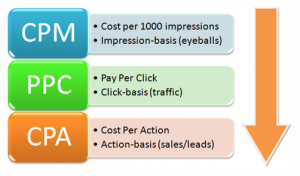
Following on from the problems highlighted here: The dirty secret of online marketing – let’s take a look at some of the challenges around properly measuring lead sources when the customer calls you.
Unless your website doesn’t have a phone number on it, some of the visitors to the site will call. To make this very clear, if you are not able to measure inbound calls and attribute them into your reporting on campaign effectiveness you will have flawed data. Bad data almost always leads to bad decision-making.
Here is an extreme example:
- Campaign 1: Contextual advertising on your favourite search engine: eCPC €1, click-to-lead 1%, cost-per-lead = €100
- Campaign 2: Display advertising on your favourite expat website: eCPC €3, click-to-lead 3%, cost-per-lead = €100
Same value for money. But if the higher click-to-lead from Campaign 2 also transfers to inbound calls and half of the visitors call, the math quickly changes:
- Campaign 1: Contextual advertising on your favourite search engine: eCPC €1, click-to-lead 1%, click-to-call 1%, cost-per-lead = €50
- Campaign 2: Display advertising on your favourite expat website: eCPC €3, click-to-lead 3%, click-to-call 3%, cost-per-lead = €33
I wrote ‘extreme example’ before, but we have seen real-world cases where improvements in inbound call measurement meant that advertisers had to completely re-evaluate their spend based on real data. The major risk in an unmeasured environment is that the inbound call performance is attributed to all marketing activity based on the spend or impressions. This can present a completely false picture.
I convinced you this is important?
How to fix the problem? The bad news is that the only way to really get 100% on this is hard.
The easiest and most common way to try and do attribution for an inbound call is to ask “where did you hear about us?” In some cases, a caller will be able to identify the exact source and the person receiving the call will log this correctly.
You want some scary data? Some websites have a “How did you hear about us?” drop-down menu on their contact form – studies have shown that up to 90% of respondents choose the first one in the list (even when this is rotated randomly).
A person receiving calls is usually paid or evaluated on results, so attribution is the last thing on their minds (and call-centre data follows user data – it doesn’t matter what the first option is, it automatically becomes the most popular).
The inbound caller really doesn’t care about identifying this as they are just trying to get a price or buy something. In addition, most people have a lot of difficulty actually answering the question. If I use Google to search for the best solution for my car insurance in Singapore, find a webpage about car insurance in Singapore and call the provider on the page, then get asked “how did you find us?”, the answer in my mind may very well be Google or “on the Internet” or “your website”. None of which might be the real reason you got a call.
Doing it properly
To ensure coherent and accurate tracking of the performance of online marketing spend you need to be able to track inbound calls properly. This means doing the following:
- For the call-centre you need to establish a series of different phone numbers from which you can pull a report to see the number of inbound calls to each number.
- On your site you need to push a permanent cookie onto the visitor’s machine which identifies the source of the click when it arrives from a campaign.
- You then need to modify your website to serve a different phone number depending on the click source in the cookie.
- When people call you will now know which slice of your budget generated each call.
Bingo!
Without this kind of marketing intelligence you could end up spending more on the cheapest impressions you can find as this ‘makes sense’. With it, you could get an ugly surprise which means they really don’t make sense any more. It might mean that several marketing options with the same price and ‘results’ suddenly don’t look the same.
Budgets for marketing are always under pressure from the ‘business’ or ‘management’. When times are tough, marketeers are forced again and again to justify their spend. You want to survive and profit? Consider why a small investment based on the points above could save a lot of money next month, year and beyond. If you want to know where to cut spend, it could be the most important thing you can do to make that happen without strangling your business by making the wrong decisions.
Questions? Drop them in the comments below.
Want help? Get in touch.
Absolutely! There are very few people in Europe (a few more in the US) even trying to get this one fixed. It’s mind-blowing people can drop a couple of million on marketing, same again in the call-centre and not actually drop the max 10-20k it takes to fix this problem.
It IS amazing indeed, that something so simple and so basic and so easy to solve (different phonenumbers for different campaigns) is more the exception then the rule.